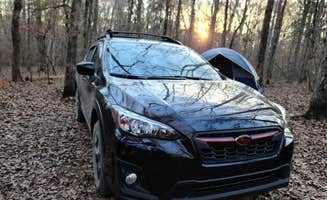Uwharrie National Forest provides the primary dispersed camping options for those seeking free camping near Cheraw, South Carolina. The forest encompasses over 50,000 acres with elevations ranging between 300-900 feet above sea level, creating a mix of rolling terrain and modest peaks. While not mountainous by Appalachian standards, the forest offers diverse microclimates that support mixed hardwood forests and pine stands, with seasonal temperature variations that make spring and fall particularly comfortable for camping.
What to do
Kayak access camping: Paddle down the Little River to reach remote camping spots with minimal foot traffic. "Me and my friends would always float our kayaks down the river to a place we called 'Bird Dog' and camp for the night. If you are looking for a place that has very little traffic, this is the place you want to go!" notes Wyatt M. about Uwharrie National Forest. A boat ramp is available where Pekin Road crosses the Little River.
Hiking trails: The 20-mile Uwharrie Trail runs north-south through the forest, offering multiple access points to backcountry camping. "It should be no shock to those familiar with North Carolina's geography that if one is seeking higher altitudes and breathtaking overlooks, Uwharrie is not the place he should go. Notwithstanding, as much of the higher elevations are impassable during the winter months, the forest offers backpackers an opportunity to stay on the trail a few days," explains Sean R. The trail can be challenging to follow in sections, particularly after heavy rain.
Off-road adventures: Uwharrie features extensive OHV trail systems open to Jeeps, ATVs, and dirt bikes. "First time at Uwharrie and we drove about 5 hours to get there but it was worth it! We also took our Jeep on the OHV trails and had a blast," shares Erica about her experience. Most OHV areas require purchasing day or overnight passes from nearby stores like Eldorado Outpost.
What campers like
Private camping spots: The forest offers numerous secluded sites away from developed campgrounds. "Plenty of space and trees and privacy!" notes Erica about Dispersed Camping off Falls Dam Trail. These sites typically feature established rock fire rings and flat areas for tent setup, though they lack amenities.
Reliable water sources: Multiple streams flow throughout the forest, providing filtration opportunities. "The streams, provided one has filtration or iodine tablets, provide ample sources of drinking water," writes Sean R. Many campsites are strategically positioned near water sources, with Wayne R. noting his campsite along the Uwharrie trail had "water available on both sides of camp/trail."
Hunting opportunities: The forest provides hunting access during designated seasons. "This area was a place that I went often to deer hunt in the fall. I have never came across another camper/hunter at this location. It is a good location if you are looking for an area that is away from camp grounds and heavy traffic," shares Wyatt M. about a specific area southwest of Troy, NC.
What you should know
Vehicle requirements: Many dispersed sites demand high-clearance or 4WD vehicles. "This is a great area for dispersed campers with 4WD or AWD. It's pretty popular so head out early to secure your spot," advises Zachary S. about Uwharrie National Forest. Forest roads frequently become challenging after rainfall.
Trail conditions: Be prepared for potentially unclear trail markings and seasonal flooding. "The trailhead is kind of hard to follow sometimes, sections of the trail are prone to flooding and creek crossings can become difficult following heavy rains," warns Sean R. Carrying detailed maps is recommended as cell service is limited.
Pack out trash: Some sites suffer from previous visitors leaving garbage. "Some of the sites may have a little trash left from the last user, so please try to leave it cleaner than you came to," suggests Zachary S. All waste must be packed out as no disposal services exist at dispersed sites.
Tips for camping with families
Safety during hunting seasons: If camping with children during hunting season, take extra precautions. "Make sure to wear bright colors during hunting season because there are a ton of people out deer hunting in this area," cautions Brandon D. about Uwharrie National Forest. Orange vests or hats are strongly recommended for all family members.
Choose appropriately accessible sites: For families with young children, select sites with easier access. "The tent sites nice and clean and level. The host drove through many many times in the 3 days I was there," reports Chris, suggesting campground sites might be more suitable for families than remote backcountry locations.
Plan for true primitive conditions: Prepare children for the lack of facilities. "Personally, I would give dispersed camping here four or five stars, but I have to be objective from the point of view of many campers. This is not an RV camping area, at least not the dispersed camping area... it is completely primitive," explains Myron C. Families should practice proper waste disposal techniques before arrival.
Tips from RVers
Size limitations: Most dispersed sites cannot accommodate large rigs. "We stayed in 2 different dispersed primitive sites and they were both great. Plenty of space and trees and privacy!" shares Erica about Uwharrie National Forest, but notes these areas are best suited for smaller setups. Pop-up campers and small trailers fare better than full-size RVs.
Generator options: Some areas allow generator use for basic power needs. "We used our pop-up with a generator in rustic locations," mentions Bart, indicating that power options exist for small campers in certain forest areas. However, generators are not permitted in all dispersed camping zones.
Tire management: If bringing a trailer on forest roads, air down tires for better traction. "There's a store/gas station (Eldorado Outpost) right down the road and they also have an air compressor for inflating tires (which is handy for off-roading)," notes Erica, highlighting an important resource for RVers tackling the forest's unpaved access roads.



